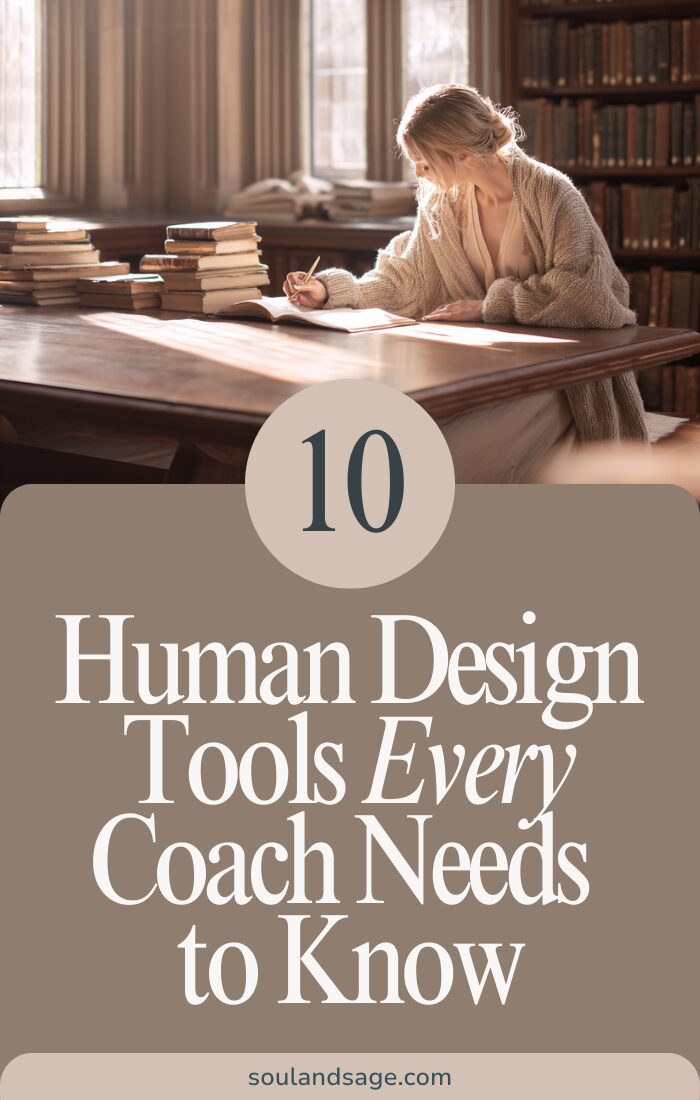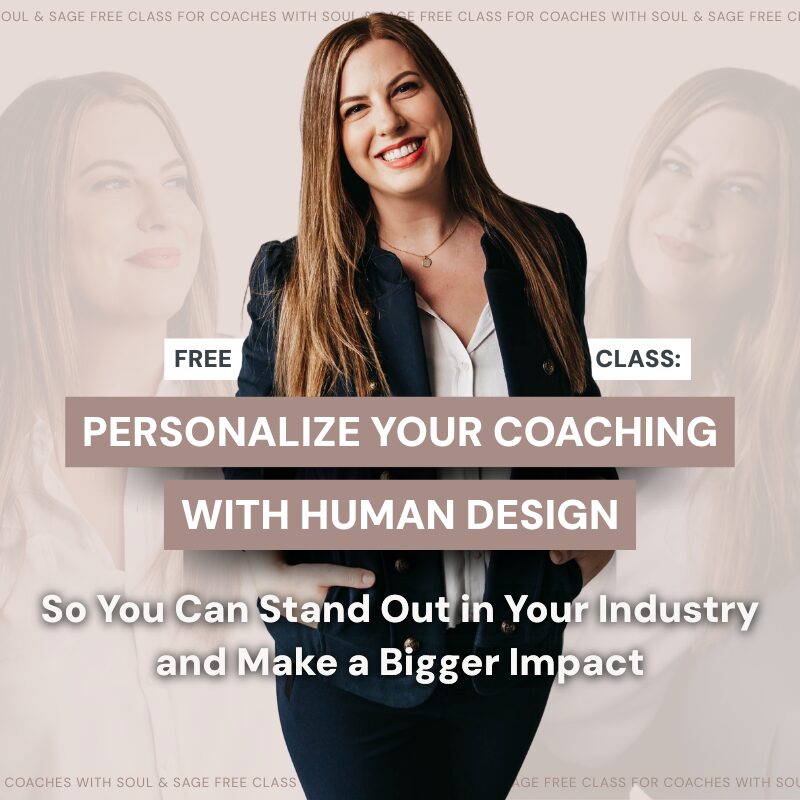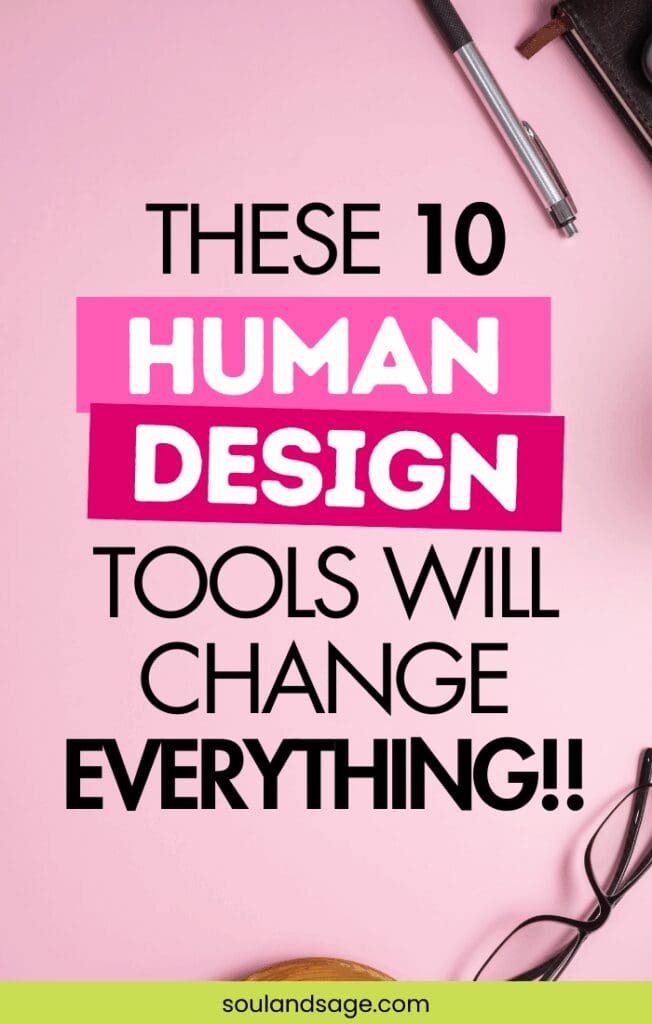Human Design is hands down one of the most powerful tools you can bring into your coaching practice. But I totally understand that it can also feel like a lot when you’re first starting out.
With all the Gates, Channels, arrows, lines, colors, and layers, you might be wondering:
“What do I actually need to know to use Human Design with my clients?”
The good news is that you don’t need to memorize the entire system (*sigh of relief*).
There are some key Human Design tools for coaches that will transform the way you support your clients, structure your sessions, and guide your clients toward meaningful breakthroughs.
Whether you’re brand new to Human Design or already weaving it into your work, these 10 tools will help you personalize your coaching, share insights that resonate, and go deeper with clients. Ready to see what they are? 👇

10 Human Design Tools for Coaches
Generate your client’s chart here and let’s explore these 10 tools together. Starting with…
Tool #1. Type
Your client’s Type tells you how they’re designed to move through the world. It sets the energetic tone for how they work, interact with others, and impact the people around them.
There are five Types: Manifestor, Generator, Manifesting Generator, Projector, and Reflector. Each Type has its own unique strengths, challenges, aura, and purpose within the Collective.
Why it matters:
Understanding each client’s Type helps you coach in a way that aligns with how they naturally operate. You can also tailor your coaching sessions, suggestions, and pacing based on your client’s Type. For example, a Projector client might love deep, reflective questions, while a Manifesting Generator might prefer dynamic sessions where they can pivot quickly.
Application:
Adapt your coaching style, tools, pacing, and recommendations based on your client’s Human Design Type. I share more tangible tips for doing this in this post all about Coaching the 5 Types.
Tool #2. Strategy
Strategy is the most aligned way for your client to take action and respond to the world around them. It’s based on their Type—specifically, the nature of their aura.
For example, the Manifestor Strategy is “To Inform” before taking actions that could impact others, while the Projector Strategy is to “Wait for the Invitation” before sharing their wisdom and guidance.
Why it matters:
I’m sure you’re well aware that coaching usually involves navigating relationships of some kind. Strategy tells you how your client is meant to operate within their relationships and interactions with others. When they follow their Strategy, they meet less resistance and avoid creating friction between them and others.
Application:
Guide clients back to their Strategy when they’re feeling stuck, uncertain, or are experiencing some kind of unease in their relationships. The four Strategies are:
- Generators and MGs: To respond (with their Sacral)
- Manifestors: To inform before acting
- Projector: To wait for the invitation
- Reflectors: To wait a lunar cycle before making a big decision or action
Tool #3. Not-Self Theme & Signature
Every Type has a Signature (how alignment feels) and a Not-Self Theme (the feeling that arises when they’re off-track or out of alignment with their design and energy). Here are the Signatures for each Type:
- Manifestor: Peace
- Generator and MG: Satisfaction
- Projector: Success
- Reflector: Surprise
And here are the Not-Self Themes:
- Manifestor: Anger
- Generator and MG: Frustration
- Projector: Bitterness
- Reflector: Disappointment
Why it matters:
Signature and Not-Self Theme give your clients a built-in self-assessment tool. They’ll know when to pause, reassess, and shift (i.e., when they experience their Not-Self Theme) vs. when they’re moving in the right direction and should stay the course (i.e., when they experience their Signature).
Application:
Help your clients learn what alignment actually feels and looks like for them, and gently guide them in course-correcting whenever they fall into their Not-Self Theme. These tools basically act as a Green light and a Check Engine light—but for your client’s life rather than their car.
Tool #4. Authority
Authority is how your client is designed to make decisions. Along with Strategy, Authority is at the core of taking aligned action in Human Design. There are seven different Authorities:
- Emotional
- Sacral
- Splenic
- Ego/Heart
- Self-Projected
- Mental
- Lunar
Why it matters:
Coaching (and life in general) is decision-heavy. From business strategies to relationships to personal growth… we each make decisions all day long, every day. And supporting your clients to trust and follow their Authority is incredibly empowering.
Application:
Teach your clients to experiment with Authority in real time, reflect on their decision-making process, and build trust in their unique form of guidance.
Click here to read more about the seven Authorities and how to use this as a powerful coaching tool.
Tool #5. Profile
Your client’s Profile tells you how they learn best, how they relate to others, and how they’re meant to share their gifts and knowledge with others.
- If they have a 1 in their Profile: They learn best through research, investigation, and digging deep into things.
- If they have a 2 in their Profile: They aren’t here to learn from an external source or authority; their gifts and knowledge are an innate part of them.
- If they have a 3 in their Profile: They learn best through trial-and-error, making mistakes, and hands-on discovery.
- If they have a 4 in their Profile: They are here to share their gifts and knowledge with their community and network. Relationships are very important to them.
- If they have a 5 in their Profile: They are here to use their gifts and knowledge to provide innovative and practical solutions to others, often strangers.
- If they have a 6 in their Profile: They are here to be wise, objective role models and to lead by example.
Why it matters:
Profile influences the “how” of coaching, including what kinds of support will work best and how your client is naturally meant to share their magic with the world.
Application:
You can tailor your communication style, suggestions, and “homework” to each client’s Profile. For example, a 1/3 may love research and experimenting, while a 6/2 needs to embrace their natural talents and focus on their own alignment rather than trying to force their knowledge onto others.
Tool #6. Motivation
Beneath the surface of your client’s chart is their Motivation. This is what drives them into action when they’re operating from alignment.
There are 6 Motivations your client can have:
- Fear: Motivated by their fear of the unknown
- Hope: Motivated to trust, let go, and hold the faith
- Desire: Motivated to get involved to create change
- Need: Motivated by what is essential or needed, but currently missing
- Guilt: Motivated to fix or improve things that don’t meet their standards
- Innocence: No specific motivation. “Anti-agenda” people.
Why it matters:
Motivation should be a guiding force behind your client’s business, career, goals, relationships, and values. However, it’s common for each of us to fall into our “Transferred Motivation” at times. Your Transferred Motivation is 3 numbers away from your actual Motivation. For example, the Transferred Motivation for Fear (1) is Need (4), and vice versa.
When you or your client recognize they’ve fallen into their Transferred Motivation, you can help them course-correct and return to what’s most aligned for them.
Application:
Help each client understand what fuels them, so they can take action in the right way at the right time. Gently point out when you notice they’re operating from their Transferred Motivation and steer them back to what’s correct for them.
Tool #7. View (Perspective)
Your client’s View (or Perspective) is the lens through which they’re designed to see the world. For example, two people might be tangibly looking at the exact same thing, but they “see” and understand that thing through in a different way. They might even notice certain aspects of it while disregarding others.
Here are the six Human Design Views and what they mean:
- Survival View: Looking for potential risks and dangers so they can be avoided.
- Possibility View: Looking for all the possibilities and options available.
- Power View: Looking for things that are breaking down or falling apart, as well as how things (or people) measure up to each other.
- Wanting View: Looking for what will benefit their family or community, but is currently missing.
- Probability View: Looking for the option that is most probable to work, as well as how things can be improved.
- Personal View: Looking at how things impact or relate to them personally.
Why it matters:
When your clients view the world through their correct View, they see what they are meant to see. This helps ensure they’re moving along their correct path in life. However, when they look at the world through a distorted view (known as their “Distraction”) they will either see the wrong things in the wrong way, or miss the things they’re supposed to see.
Application:
Lovingly guide your clients back to their correct View when you can see they’ve fallen into their Distraction. Remind them that they aren’t meant to focus on so many different things or try to see the world through a bunch of different lenses. They are here to look at the world through a very specific frame.
Tool #8. Definition
Definition refers to how your client’s defined Energy Centers connect to each other, or not. Can energy flow smoothly through their chart between all defined Energy Centers, or are there “splits” (i.e., breaks) in the energy flow?
If your client has no splits in energy flow, they have Single Definition.
One split means they have Split Definition (sometimes called Simple Split). Two splits is called Triple-Split, and three is called Quad-Split.
Why it matters:
Your client’s Definition tells you how quickly they process information, how they integrate (or struggle to integrate) insights, and where they have a disconnect in energy flow between their Centers.
A Single definition client may process information quickly, while a Split definition may need more time or conversations to “bridge” different parts of their Design—i.e., connect them together.
Definition can also reveal whether your client is more vulnerable to conditioning through their undefined Centers (for Single and Triple-Split Definitions) or through their “Bridge” Gates and Channels (for Split and Quad-Split Definitions).
Application:
Identify the areas of your client’s chart that leave them most vulnerable to energetic conditioning. Adjust the speed and style in which you deliver information to better suit your client’s Definition and processing speed. You may also be able to use your own energy and definition to “bridge” the energetic splits in your client’s chart.
Tool #9. Energy Centers
Your client’s defined Energy Centers are consistent sources of energy for them. For example, a defined Heart Center gives your client consistent access to their willpower, and a defined Spleen means they have consistent access to their intuition and instincts.
On the other hand, undefined Centers are where your client absorbs energy from the people around them. This is how energetic conditioning occurs. However, their undefined Centers can also become great sources of wisdom and areas for immense personal development over time.
Why it matters:
Each Center in your client’s chart reveals so much about who they are, how they’re designed to operate, where they’re most susceptible to conditioning, and how they can move through life more effectively.
Application:
Support your clients in deconditioning their undefined Centers, starting with the “Not-Self Question” of each Center. For example, the Not-Self Question of the Heart Center is: “Do I think I have something to prove?”
For their defined Centers, help your client correctly harness these energies. For example, help them use their defined Throat Center (and any activated Gates and Channels in the Throat) to confidently express themselves in the most aligned way.
Tool #10. Environment
Your client’s Human Design Environment is where they thrive—physically, energetically, and creatively. There are six Environments, and the name of each is symbolic of the type of place it represents.
- Caves (places of safety and security)
- Markets (places of physical exchange)
- Kitchens (places of creation and transformation)
- Mountains (places with an elevated perspective)
- Valleys (places of connection and information)
- Shores (places with boundaries, horizons, or where two spaces connect)
Why it matters:
When your client is in the right Environment for their Design, they feel more like themselves, are healthier, and can take the right kinds of action. This supports their nervous system regulation, their physical body, their decision-making abilities, and their overall wellness and alignment.
Application:
Help your clients experiment with how their environment (their home, office, etc.) impacts their energy, creativity, health, and connection to self. For a fantastic resource diving into each of the six Environments and how to best work with them, check out Vaness Henry’s blog.
Human Design doesn’t have to feel so overwhelming. In my free 25-minute class, I’ll show you how to start using Human Design with your coaching clients in the next 30 days or less.
👉 Watch the on-demand class here

Loved this post? Save it on Pinterest! ↓


Share this post: